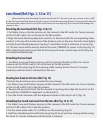
TO ENSURE LONG-TERM SATISFACTION
Avoid touching the glass element surface. Use a photographic lens cloth or a blower
to remove dust from the lens element surface. When not using the lens, always place a lens
cap on it for protection.
Use a lens cleaning tissue or lint cloth with a drop of cleaning solution to remove fin-
gerprints or dirt on the glass lens surface with a rotary motion from the center to the edges.
Use a silicon cloth to clean your lens barrel only.
Mildew is an enemy of your lens. Clean the lens after shooting near water or in any
humid place. Store your lens in a clean, cool, dry place. When storing your lens in a lens case,
store it with commercially available drying agents such as silica gel, and change the agent
occasionally. If you find mildew on your lens, consult an authorized repair shop or nearby
photographic store.
Do not touch the lens-camera interface contacts since dust, dirt and/or stains may
cause a contact failure between the lens and camera.
When using your equipment in an environment where the temperature changes from
one extreme to another, make sure to put your equipment temporarily in a case or a plastic
bag for a length of time in order for the equipment to go though a gradual temperature,
this will reduce potential equipment trouble.
The image circles of Di-II lenses are designed to match the digital SLR cameras using
the image sensors equivalent to APS-C (approx. 15.5 x 23.2mm). Do not use Di-II lenses with
such cameras as it may cause vignetting on the image.
A17 employs an internal focusing (IF) system. Because of the characteristics of this
optical design, the angles of view at distances other than infinity are wider than that of the
lenses applying an ordinary focusing system.
When the built-in flash on the camera is used, adverse photographic phenomena
such as corner illumination, fall-off, or vignetting at the bottom part of the image may be
observed, especially with wide angle ranges. This is due to the inherent limitation of the
coverage of the built-in flash, and/or the relative position of the flash to the edge of the lens
barrel which causes shadows on the image. It is strongly recommended to use a suitable
separate flash unit provided by the camera manufacturer for all flash photography.
When using the lens in the telephoto focal range, please be careful with the camera
shake. Effective way to avoid the camera shake is using an ISO setting of higher numbers.
Using a tripod or monopod is also effective.
When set on AF mode, interfering with the focusing ring may cause serious damage to the
lens mechanism.
Certain camera models may indicate the maximum and minimum aperture values of
the lenses appropriate numbers. This is inherent to the design of the camera and not an
indication of error.
When using a special filter such as a PL filter on the A16, use low-profile filters. The
thick rim of a normal filter may cause vignetting.











